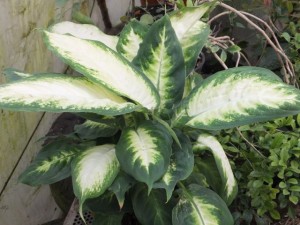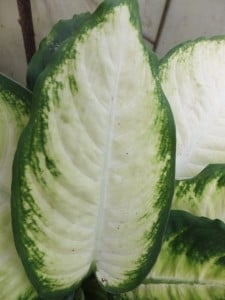 Of the many poisonous greenhouse, conservatory and house plants one you come across almost everywhere is Dieffenbachia, the Dumb Cane. This is a delightful architectural foliage plant with large attractive variegated leaves, and seldom has it caused accidents. Still you should be aware the sap is very irritant and poisonous and so this genus should be avoided if you have young children, or pets that nibble plants.
Of the many poisonous greenhouse, conservatory and house plants one you come across almost everywhere is Dieffenbachia, the Dumb Cane. This is a delightful architectural foliage plant with large attractive variegated leaves, and seldom has it caused accidents. Still you should be aware the sap is very irritant and poisonous and so this genus should be avoided if you have young children, or pets that nibble plants.
Indeed the name Dumb Cane, sometimes the Mother-in-law plant, comes about because if the sap is touched on the tongue it renders the person speechless for up to three days. The sap can paralyse the throat as well and prevent swallowing and even stop breathing.
However before you panic I must point out that no child has been killed in the UK for more than fifty years from eating a plant or mushroom whereas too many have been killed by consuming household products especially inappropriately stored liquids.
Dieffenbachia is a tropical South American genus of several dozen species somewhat resembling the even more popular Caladiums which are also in the Aroid family. Natives of warm jungles they have fleshy stems and large broad green leaves that are striped, spotted or mottled with white, yellow or light brown. They are neat and most attractive when young and less than a couple of feet across and tall. As they get older they get leggy and top heavy and become much less attractive. Some can reach eight feet or more, before then they are better cut up into sections and rooted as new plants otherwise they might collapse and topple over.
You could start with seed but as is so often the case the very choicest forms are only propagated by vegetative means so are best bought. However as these grow fairly quickly a small one can soon be grown up, and later divided into more.

Dumb canes are unhappy too cold, they die away below 50-60° F and like it hotter and preferably humid. They need good light especially in winter as they need to keep growing or they fade away, conversely too bright conditions may scorch them. They are also rather sensitive to draughts and oil or gas fumes can make them sick. An occassional wipe with a damp cloth will be appreciated.
As with so many jungle plants Dieffenbachias need leaf mould rich, moist well drained compost, a generous pot and only watering with rain water, preferably warm. Use terracotta pots as their weight helps balance the relatively massive tops.
The species you find most often will be D. amoena, arvida and picta, these come in a host of cultivated varieties and hybrids but there’s little difference in their treatment. For the connoisseur there are many other species some with even more striking patterns, marbling, some shiny, some satin others with depressed veins. Sadly many of these require hotter and more humid conditions than most of us can maintain.


